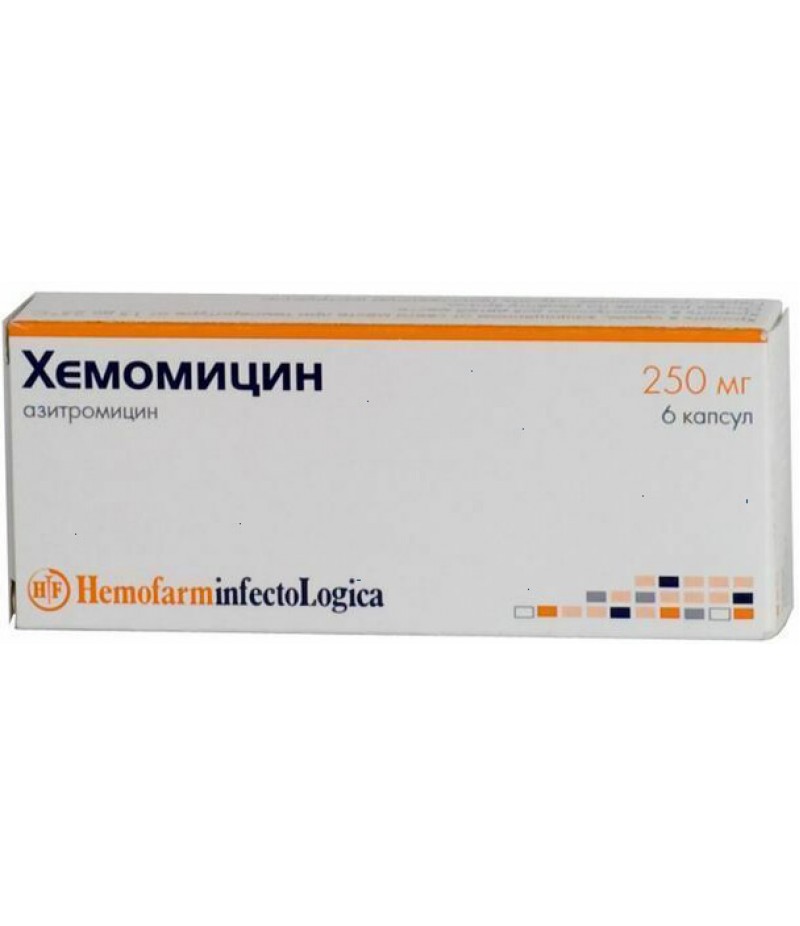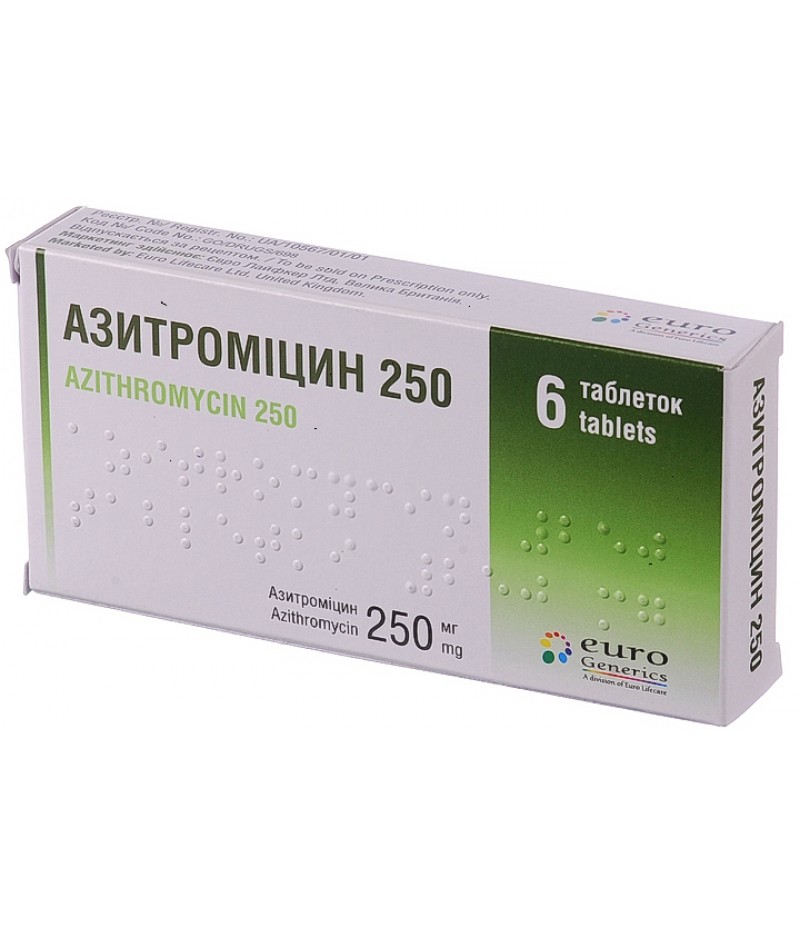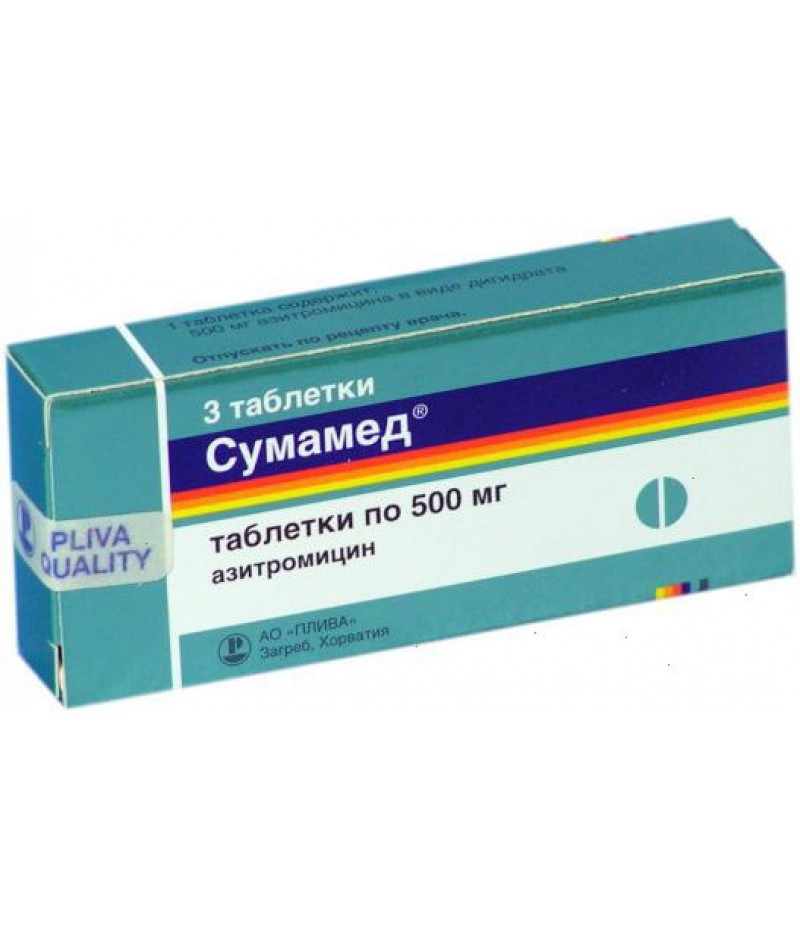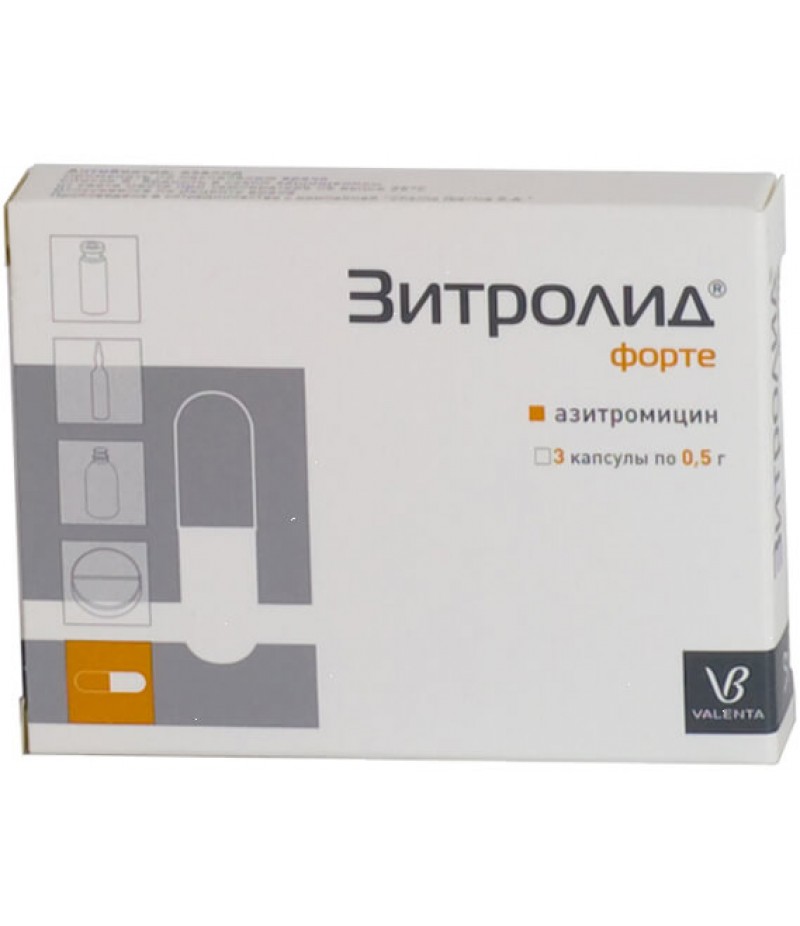Hemomycin caps 250mg #6
- $15.69
- 3 or more $14.99
- Availability:In Stock
Hemomycin user manualYou can buy Hemomycin onlineCompositionComposition of capsules Hemomycin:One capsule contains the active substance: azithromycin - 250 mg (in the form of azithromycin dihydrate - 262.03 mg). Excipients: anhydr..
Tags: caps
Hemomycin user manual
You can buy Hemomycin online
Composition
Composition of capsules Hemomycin:
One capsule contains the active substance: azithromycin - 250 mg (in the form of azithromycin dihydrate - 262.03 mg). Excipients: anhydrous lactose, corn starch, magnesium stearate, sodium lauryl sulfate. The capsule shell consists of: titanium dioxide, a patented blue dye, gelatin.
Powder composition for suspension preparation for oral administration (5 ml):
Active substance: azithromycin - 100 mg or 200 mg, depending on the dosage (in the form of azithromycin dihydrate - 104.809 mg or 209.6 mg, depending on the dosage). Excipients: xanthan gum, colloidal silicon dioxide, sodium saccharinate, calcium carbonate, strawberry flavor, sodium phosphate anhydrous, sorbitol, apple flavor, cherry flavor.
Composition of tablets in a film shell:
One tablet contains the active substance - azithromycin - 500 mg (in the form of azithromycin dihydrate). Excipients: silicate cellulose, MCC, sodium carboxymethyl starch, povidone, magnesium stearate, talc, colloidal silicon dioxide.
The composition of the film sheath includes: ethyl cellulose, titanium dioxide, talc, macrogol 600, indigocarmine, copovidone, dye lacquer green, quinoline yellow.
Composition of lyophilizate for the preparation of an infusion solution:
One bottle contains azithromycin (in the form of dihydrate) 500 mg. Excipients: monohydrate of citric acid, mannitol, sodium hydroxide.
Form of issue
Hemomycin is available in four forms:
Capsules - blue, inside contains white powder; 6 such capsules in a blister, one such blister in a cardboard package.
Powder for the preparation of a suspension for oral administration - has a white or close to white color with a fruity aroma (the prepared suspension is almost white with a fruity aroma); 10 grams (at a dosage of 200 mg) or 11.43 grams (at a dosage of 100 mg) of a powder in a vial of dark glass with a measuring spoon, one such bottle and a measuring spoon in a cardboard bundle.
Tablets - a round shape with convex sides, covered with a shell of blue color; three such tablets in a blister, one such blister in a cardboard package.
The lyophilizate is a powder or compressed into a tablet with a white mass; 500 mg of such a powder in a glass bottle, one such bottle in a cardboard bundle.
pharmachologic effect
Antibacterial (bactericidal and bacteriostatic) action.
Pharmacodynamics and pharmacokinetics
Pharmacodynamics
Azithromycin belongs to the azalides, a newly synthesized group of macrolide antibiotics. Once in the cell of the microorganism, it reacts with the 50S subunit of the 70S ribosome, thereby stopping the RNA-dependent production of the protein and stopping the multiplication of the bacteria. When a high concentration is achieved, azithromycin produces a bactericidal effect.
Has a wide range of antibacterial action. Sensitive to azithromycin microorganisms:
Gram-positive cocci - Streptococcus roogenes, Streptococcus pneumonie, C, F and G group of streptococci, Streptococcus agalactiae, S. viridans;
Staphylococcus aureus;
Gram-negative bacteria - Legionella pneumophila, Bordatella pertussis, Haemophilus influenzae, H. rarenfluenzae, Neisseria gonorrhoeae, H. ducrei, B. rarapertussis, Campylobacter jejuni, Gardnerella vaginalis (azithromycin does not affect gram-positive microorganisms resistant to erythromycin);
anaerobic bacteria - Clostridium perfringes, Ureaplasma urealyticum, Bacteroides bivius, Peptostreptococcus species, and Mycoplasma pneumoniae, Chlamidia trachomatis, Treponema pallidum.
Pharmacokinetics
Azithromycin is rapidly adsorbed from the digestive tract. Bioavailability reaches 37%. The maximum concentration of azithromycin in the blood is reached after 3-3,5 hours after ingestion. The drug penetrates well into the tissues of the respiratory and genitourinary system, as well as into the skin and soft tissues. Antibiotic Hemomycin in large concentrations accumulates in macrophages, which deliver it to the infectious inflammatory focus and release.
A third of azithromycin is metabolized in the liver, another half is excreted in the bile form in its original form, the remainder is excreted in urine in three days. The half-life is 14-19 hours.
Indications for use
Infectious-inflammatory diseases:
Respiratory and ENT organs (sinusitis, tonsillitis, tonsillitis, pneumonia, otitis media, bronchitis).
Soft tissues and skin (impetigo, erysipelas, secondarily infected dermatoses).
Genitourinary tract (urethritis, cervicitis).
Stomach and duodenum associated with Helicobacter pylori (as part of multicomponent therapy).
And also Lyme disease and scarlet fever;
Contraindications
Allergy to azithromycin or another representative of the macrolide group.
Heavy lesions of the liver, kidney.
Lactation.
With caution: pregnancy, arrhythmia (possible abnormalities of the ventricular rhythm and lengthening of the segment QT); children with marked changes in liver or kidney function.
The age is under 12 years and the weight is up to 45 kg in children (for capsules, tablets and suspension with a dosage of 200 mg), up to 6 months (for suspension with a dosage of 100 mg).
Use with caution in pregnancy and rhythm disorders.
Side effects
Side effects caused by capsules:
On the part of the digestive tract: nausea, abdominal pain, diarrhea, vomiting, a temporary increase in the activity of transaminases and other hepatic enzymes; rarely - melena, jaundice.
Dermatological reactions: rash.
Suspension and tablets can cause the following side effects:
From the digestive tract: diarrhea, vomiting, nausea, abdominal pain, flatulence, melena, jaundice, a temporary increase in the activity of transaminases; children - lack of appetite, constipation, gastritis.
From the side of the cardiac system: tachycardia, chest pain.
From the side of the central nervous system: pain in the head, dizziness, drowsiness; children - hyperkinesia, anxiety, insomnia.
From the genitourinary system: nephritis (rarely), vaginal candidiasis.
Allergic reactions: rash, angioedema; in children - conjunctivitis, urticaria.
In very rare cases - candidiasis of the oral cavity.
Instructions for use Hemomycin
Instructions for Hemomycin recommends taking the antibiotic orally (tablets, suspension, capsules) once a day for 1 hour before or 2 hours after eating, since sharing with the food intake of Hemomycin reduces the bioavailability of the drug.
With infectious and inflammatory diseases of the respiratory system, adults are prescribed Hemomycin 500 mg per day for three days.
For infectious and inflammatory diseases of soft tissues and skin, and also at the initial stage of Lyme disease, 1 gram is prescribed on the first day, then 500 mg once a day from the second to the fifth day.
In acute urethritis or cervicitis, one gram of azithromycin is recommended once.
With diseases of the duodenum and stomach associated with Helicobacter pylori, take 1 gram per day for 3 days as part of a multicomponent antihelikobakternoy therapy.
For infectious and inflammatory diseases of the respiratory tract, soft tissues and skin for children from 12 years, the drug is prescribed at a rate of 10 mg / kg once a day for 3 days, with treatment of the initial stage of Lyme disease - 20 mg / kg on the first day and 10 mg / kg from the second to the fifth day.
Preparation of the suspension
In the vial where the powder is located, slowly add pure cold water to the mark. The vial is then shaken until a uniform suspension is obtained. Immediately after taking Hemomycin in the form of a suspension, the child should drink a small amount of pure water to swallow the remainder of the suspension in the oral cavity.
Powder for preparation of infusions
Hemomycin for the preparation of infusions is used strictly in inpatient medical institutions.
Overdose
Typical signs of an overdose: temporary hearing loss, abdominal pain, nausea, possible vomiting, loose stools.
Treatment of overdose: reception of activated charcoal, symptomatic therapy. There is no specific antidote.
Interaction
With the simultaneous administration of azithromycin and antacids, the bioavailability of the former does not change, but the concentration in the serum is reduced by an average of 25%. Hemomycin is recommended to be applied one hour before or two hours after the use of antacids.
It is known about cases of changes in the metabolism of digoxin in a single dose with macrolides. In particular, this method of digoxin with azithromycin increases the concentration of the first in blood plasma.
Patients who took macrolide antibiotics along with ergot derivatives, sometimes noted signs of alkaloid poisoning of the latter. Therefore, it is not recommended to prescribe azithromycin together with ergot derivatives.
It is recommended to use caution with azithromycin together with cyclosporine or theophylline, since it is possible to increase the concentration of the latter in the blood.
In patients taking azithromycin and rifabutin, the development of neutropenia is also possible.
The joint administration of cisapride and azithromycin in some cases causes ventricular and mertsatlnuyu arrhythmia.
Lincosamines reduce the effectiveness of azithromycin, while tetracycline and chloramphenicol are intensified on the contrary.
The simultaneous treatment with azithromycin and heparin is prohibited.
Ergothamine and its derivatives increase the toxicity of azithromycin and can cause vasospasm and changes in sensitivity.
Storage conditions
Store in a dry dark place.
Store at temperatures between 15 ° C and 25 ° C.
Keep away from children.
Shelf life - 3 years.
special instructions
It is not recommended to take Hemomycin concomitantly with food or antacids.
Allergic reactions in a number of patients may persist after the end of Hemomycin treatment.
Hemomycin analogues
Analogues of the drug are numerous, here are some of them: Azithromycin, Sumamed.
Hemomycin for children
Antibiotic in the form of capsules and tablets is prohibited for children under 12 years of age. Suspension is permitted for children older than six months. Dosage for children is calculated by the attending physician based on the specific situation.
The patients' testimonies indicate the effectiveness of using Hemomycin in children, but there are reports of side effects.
Children with liver or kidney disease should be prescribed with caution.
With alcohol
It is forbidden to drink alcohol during the treatment with Hemomycin.
In pregnancy and lactation
The intake of Hemomycin during pregnancy or during breastfeeding is justified if the perceived benefit of taking it exceeds the risks to the child. The decision to take the drug is made only by the doctor or doctor's consultation.
Reviews of Hemomycin
Reviews on the forums about Hemomycin allow you to form a positive opinion about the effectiveness of the drug. However, the use of the drug for children can result in the occurrence of side effects from the gastrointestinal tract (reports about this are not uncommon).
Which is better: Sumamed or Hemomycin?
Preparations have the same composition and in many respects the repeated forms of release and dosage. Reports about the use of drugs do not reveal a noticeable difference in the results of treatment towards any of them. Therefore, patients often choose Hemomycin because of a lower price.





